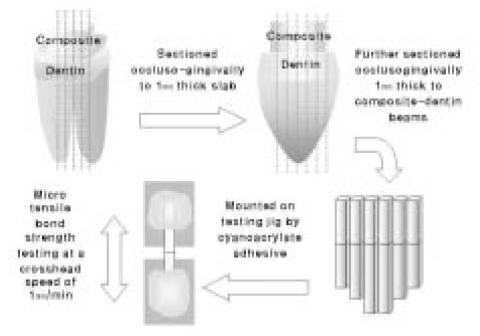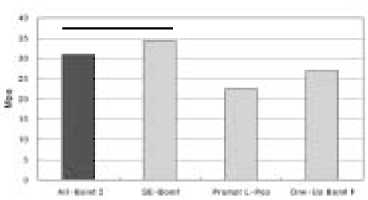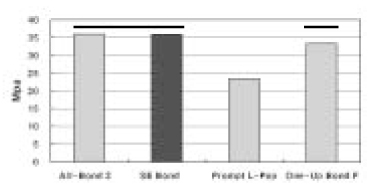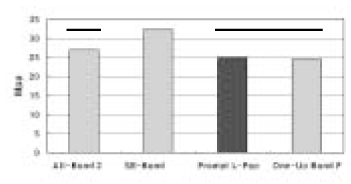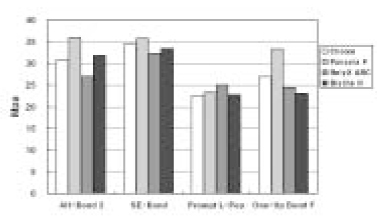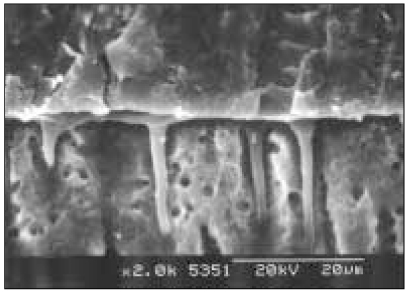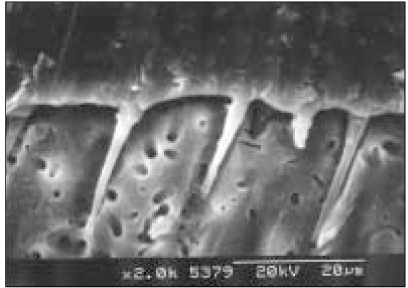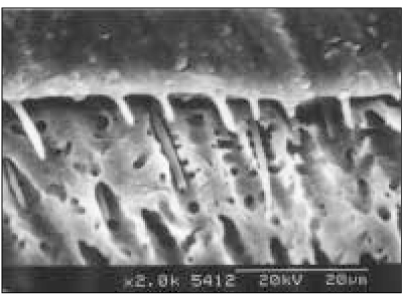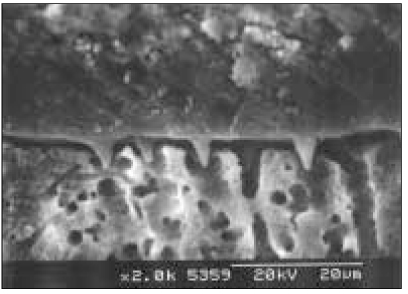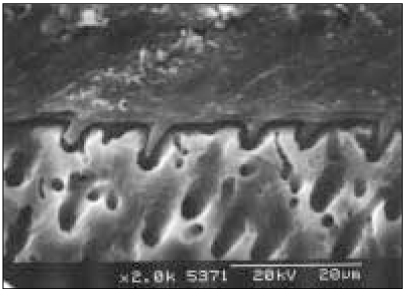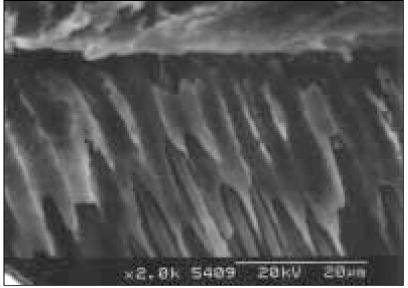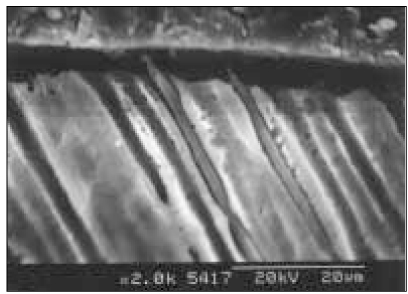Compatibility of self-etching dentin adhesives with resin luting cements
- Affiliations
-
- 1Department of Conservative Dentistry, Division of Dentistry, Graduate School, Kyung Hee University, Korea. choikkyu@khu.ac.kr
- KMID: 2175759
- DOI: http://doi.org/10.5395/JKACD.2005.30.6.493
Abstract
- This study was performed to investigate the compatibility between 4 dentin adhesives and 4 resin luting cements. Dentin adhesives used in this study were All-Bond 2 (Bisco Inc., Schaumbrug, IL, USA), Clearfil SE-Bond (Kuraray Medical Inc, Osaka, Japan), Prompt L-Pop (3M Dental Products, St. Paul, MN, USA), One-Up Bond F (Tokuyama corp., Tokyo, Japan). Resin luting cements used in this study were Choice (Bisco Inc., Schaumbrug, IL, USA), Panavia F (Kuraray Medical Inc, Osaka, Japan), RelyX ARC (3M Dental Products, St. Paul, MN, USA), Bistite II DC (Tokuyama corp., Tokyo, Japan). Combination of each dentin adhesive and corresponding resin cement was made to 16 experimental groups. Flat dentin surfaces was created on mid-coronal dentin of extracted mandibular third molars, then dentin surface was polished with 320-grit silicon carbide abrasive papers. Indirect resin composite block (Tescera, Bisco) was fabricated. Its surface for bonding to tooth was polished with silicon carbide abrasive papers. Each dentin adhesive was treated on tooth surface and resin composite overlay were luted with each resin cement. Each bonded specimen was poured in epoxy resin and sectioned occluso-gingivally into 1.0 mm thick slab, then further sectioned into 1.0 x 1.0 mm2 composite-dentin beams. Microtensile bond strength was tested at a crosshead speed of 1.0 mm/min. The data were analysed by one-way ANOVA and Duncan's multiple comparison tests. The results of this study were as follows; 2-step self-etching dentin adhesive which has additional bonding resin is more compatible than 1-step self-etching dentin adhesive.
Keyword
Figure
Cited by 5 articles
-
The bonding durability of resin cements
Min-Woo Cho, Sang-Hyuk Park, Jong-Ryul Kim, Kyoung-Kyu Choi
J Korean Acad Conserv Dent. 2007;32(4):343-355. doi: 10.5395/JKACD.2007.32.4.343.Comparison of bond strength of a fiber post cemented with various resin cements
Hyun-A Lee, Young-Gon Cho
J Korean Acad Conserv Dent. 2008;33(6):499-506. doi: 10.5395/JKACD.2008.33.6.499.The Effect of Temporary Filling Materials on The Adhesion between Dentin Adhesive-coated Surface and Resin Inlay
Tae-Gun Kim, Kwang-Won Lee, Mi-Kyung Yu
J Korean Acad Conserv Dent. 2008;33(6):553-559. doi: 10.5395/JKACD.2008.33.6.553.Effect of film thickness of resin cement on bonding efficiency in indirect composite restoration
Sang-Hyuck Lee, Gi-Woon Choi, Kyung-Kyu Choi
J Korean Acad Conserv Dent. 2010;35(2):69-79. doi: 10.5395/JKACD.2010.35.2.069.Microtensile bond strength of resin inlay bonded to dentin treated with various temporary filling materials
Tae-Woo Kim, Bin-Na Lee, Young-Jung Choi, So-Young Yang, Hoon-Sang Chang, Yun-Chan Hwang, In-Nam Hwang, Won-Mann Oh
J Korean Acad Conserv Dent. 2011;36(5):419-424. doi: 10.5395/JKACD.2011.36.5.419.
Reference
-
1. Manhart J, Scheibenhogen FA, Chen HY, Hiekel R. A 2-year clinical study of composite and ceramic inlays. Clin Oral Investig. 2000. 4:192–198.
Article2. Peumans M, Van Meerbeek B, Lambrechts P, Vanherle G. Porcelain Veneers; a review of the literature. J Dent. 2000. 28:163–177.
Article3. Mitchell CA, Abbariki M, Orr JF. The influence of luting cement on the probabilities of survival and modes of failure of cast full-coveraged crowns. Dent Mater. 2000. 16:198–206.
Article4. Knox J, Kralj B, Hubsch PF, Middleton J, Jones ML. An evaluation of the influence of orthodontic adhesive on the stresses generated in a bonded bracket finite element model. Am J Orthod Dentofacial Orthop. 2001. 119:43–53.
Article5. el-Mowafy O, Rubo MH. Retention of a posterior resin-bonded fixed partial denture with a modified design : an in vitro study. Int J Prosthodont. 2000. 13:425–431.6. Platt JA. Resin cements into the 21st century. Compend Contin Educ Dent. 1999. 20:1173–1184.7. Diaz-Arnold AM, Vargas MA, Haselton DR. Current status of luting agents for fixed prosthodontics. J Prosthet Dent. 1999. 81:135–141.
Article8. Lopes GC, Baratieri LN, de Andrada MA, Vieira LC. Dental adhesion: present state of the art and future perspectives. Quintessence Int. 2002. 33:213–224.9. Choi KK, Kim SW, Choi HY. Effect of filler addition to bonding agents on the physical properties and the bond strength to bovine teeth. The First International Congress on Adhesive Dentistry(IAD, Program and Abstracts). 2002. –434.10. Carvalho RM, Pegoraro TA, Tay FR, Pegoraro LF, Pashley DH. Adhesive permeability affects coupling of resin cements that utilise self-etching primers to dentine. J Dent. 2004. 32:55–65.
Article11. Kugel G, Ferrari M. The science of bonding: from first to sixth generation. J Am Dent Assoc. 2000. 131:Suppl. 20S–25S.
Article12. Tanumiharja M, Burrow MF, Tyas MJ. Microntensile bond strengths of seven dentin adhesive systems. Dent Mater. 2000. 16:180–187.13. Prati C, Chersoni S, Mongiorgi R, Pashley DH. Resin-infiltrated dentin layer formation of new bonding systems. Oper Dent. 1998. 23:185–194.14. Tay FR, Sano H, Carvalho RM, Pashley EL, Pashley DH. An ultra-structural study of the influence of acidity of self-etching primers and smear layers thickness on bonding to intact dentin. J Adhes Dent. 2000. 2:83–98.15. Tay FR, King NM, Suh BI, Pashley DH. Effect of delayed activation of light-cured resin composites on bonding of all-in-one adhesives. J Adhes Dent. 2001. 3:207–225.16. Tay FR, Pashley DH, Suh BI, Carvalho RM, Itthagarun A. Single-step adhesives are permeable membranes. J Dent. 2002. 30:371–382.
Article17. Cheong C, King NM, Pashley DH, Ferrari M, Toledano M, Tay FR. Incompatibility of self-etch adhesives with chemical/dual-cured composites: two-step vs one-step systems. Oper Dent. 2003. 28:747–755.18. Krämer N, Lohbauer U, Frankenberger R. Adhesive luting of indirect restorations. Am J Dent. 2000. 13:60D–76D.19. Hasegawa EA, Boyer DB, Chan DC. Hardening of dual-cured cements under composite resin inlays. J Prosthet Dent. 1991. 66:187–192.
Article20. el-Badrawy WA, el-Mowafy OM. Chemical versus dual curing of resin inlay cements. J Prosthet Dent. 1995. 73:515–524.
Article21. Blackman R, Barghi N, Duke E. Influence of ceramic thickness on the polymerization of light-cured resin cement. J Prosthet Dent. 1990. 63:295–300.
Article22. Kato H, Matsumura H, Atsuta M. Effect of etching and sandblasting on bond strength to sintered porcelain of unfilled resin. J Oral Rehabil. 2000. 27:103–110.
Article23. Hahn P, Attin T, Grofke M, Hellwig E. Influence of resin cement viscosity on microleakage of ceramic inlays. Dent Mater. 2001. 17:191–196.
Article24. Sano H, Ciucchi B, Mathews WG, Pashley DH. Tensile properties of mineralized and demineralized human and bovine dentin. J Dent Res. 1994. 73:1205–1211.
Article25. Shono Y, Ogawa T, Terashita M, Carvalho RM, Pashley EL, Pashley DH. Regional measurement of resin-dentin bonding as an array. J Dent Res. 1999. 78:699–705.
Article26. Suh BI, Feng L, Pashley DH, Tay FR. Factors contributing to the incompatibility between simplified-step adhesives and chemically-cured or dual-cured composites. Part III. Effect of acidic resin monomers. J Adhes Dent. 2003. 5:267–282.27. Attal JP, Asmussen E, Degrange M. Effects of surface treatment on the free surface energy of dentin. Dent Mater. 1994. 10:259–264.
Article28. Tay FR, Pashley DH. Aggressiveness of contemporary self-etching systems. I: Depth of penetration beyond dentin smear layers. Dent Mater. 2001. 17:296–308.29. Sanares AM, Itthagarun A, King NM, Tay FR, Pashley DH. Adverse surface interactions between one-bottle light-cured adhesives and chemical-cured composites. Dent Mater. 2001. 17:542–556.
Article30. Tay FR, Pashley DH. Water treeing-a potential mechanism for degradation of dentin adhesives. Am J Dent. 2003. 16:6–12.31. Tay FR, Pashley DH, Yiu CK, Sanares AM, Wei SH. Factors contributing to the incompatibility between simplified-step adhesives and chemically-cured or dual-cured composites. Part I. Single-step self-etching adhesive. J Adhes Dent. 2003. 5:27–40.32. Tay FR, Suh BI, Pashley DH, Prati C, Chuang SF, Li F. Factors contributing to the incompatibility between simplified-step adhesives and chemically-cured or dual-cured composites. Part II. Single-bottle, total-etch adhesive. J Adhes Dent. 2003. 5:91–105.33. Tanaka J, Ishikawa K, Yatani H, Yamashita A, Suzuki K. Correlation of dentin bond durability with water asorption of bonding layer. Dent Mater J. 1999. 18:11–18.
Article
- Full Text Links
- Actions
-
Cited
- CITED
-
- Close
- Share
- Similar articles
-
- The effect of bonding resin on bond strength of dual-cure resin cements
- The effect of additional etching and curing mechanism of composite resin on the dentin bond strength
- Effect of an intermediate bonding resin and flowable resin on the compatibility of two-step total etching adhesives with a self-curing composite resin
- Microtensile bond strength of self-etching and self-adhesive resin cements to dentin and indirect composite resin
- Effect of adhesive luting on the fracture resistance of zirconia compared to that of composite resin and lithium disilicate glass ceramic

